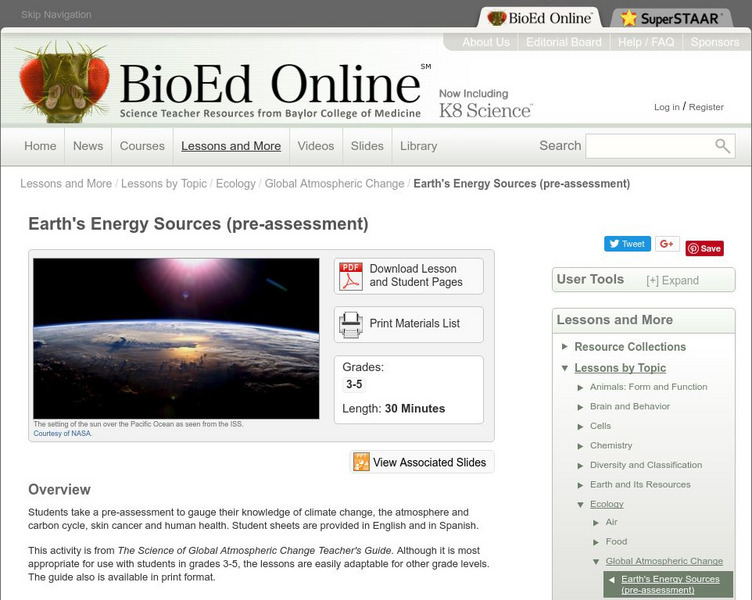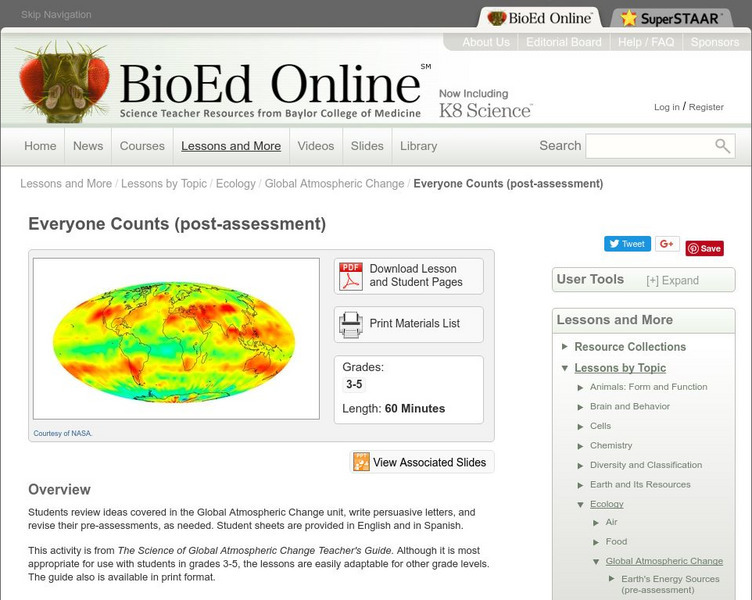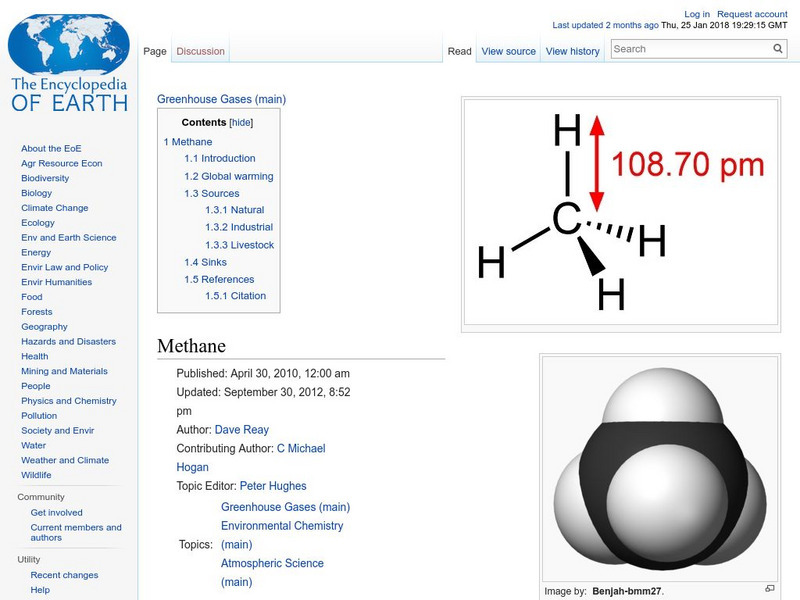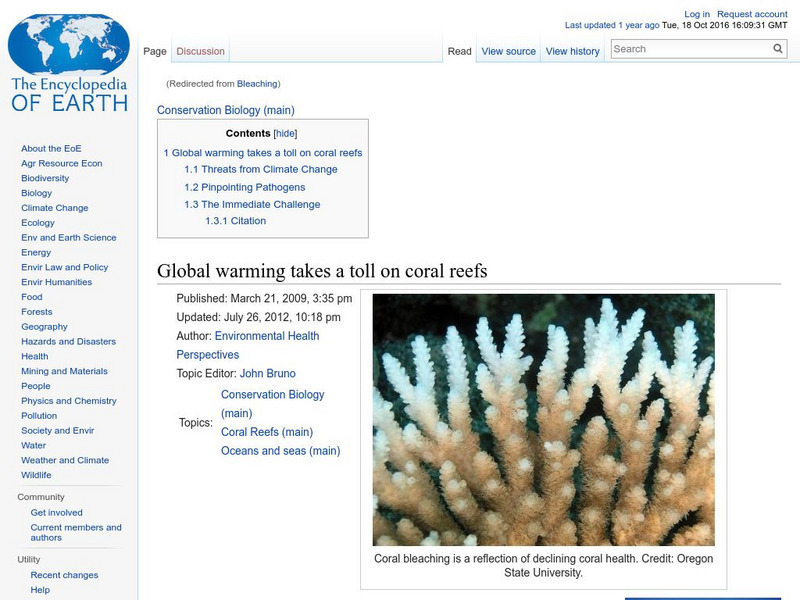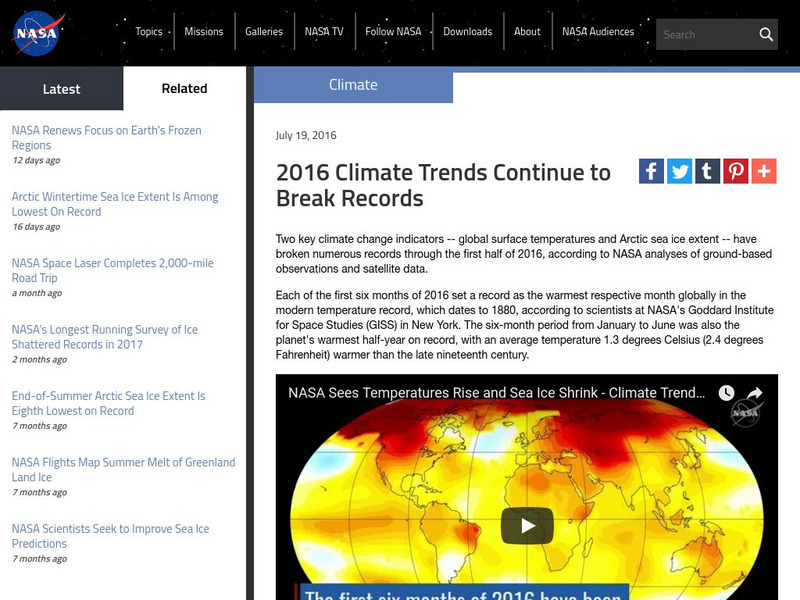Curated OER
Global Warming--Points of view
Students are introduced to global warming through analysis of political/editorial cartoons dealing with the subject. They discuss the cartoon and what the feel it means and then discuss the mechanics of and the concerns about global...
Curated OER
Glacial Change
Students research the ways in which scientists study glaciers and glacial change. They interpret real time data and calculate the estimated global sea level rise potential. A very good activity to illustrate global warming.
Curated OER
Glacier Climbing
Young scholars discuss glaciers and the current distribution of glaciers around the Earth. They create simulated glaciers using cornstarch, shoeboxes, water, and pebbles.
Curated OER
Is the Earth Warming? a Test of the Effect of Increased Carbon Dioxide on the Thermal Properties of Air
Students investigate the environmental and economic effects of increased carbon dioxide (CO2) content in the atmosphere.
NASA
Nasa Earth Observatory: Polar Ice Fact Sheet
Learn about polar ice, its effects on energy exchanges, how much surface area it covers, and how it is affected by global warming.
Georgia Department of Education
Ga Virtual Learning: Air, Atmosphere, and Climate Change
Sixteen essential questions lead student learning about Earth's atmosphere and global warming as they have to do with global climate change.
PBS
Pbs Learning Media: Co2 Concentrations at Mauna Loa Observatory, Hawaii
This resource, adapted from the Carbon Dioxide Information Analysis Center, provides a graph of monthly average carbon dioxide (CO2) concentration from 1958 to 2000 at the Mauna Loa Observatory in Hawaii.
PBS
Pbs Learning Media: What's Up With the Weather: Graphs
Examine this graph from FRONTLINE/NOVA: "What's Up with the Weather?" Web site to see dramatic increases in three greenhouse gases over the last two hundred years.
Other
Skeptical Science: Global Warming & Climate Change Myths
Close to two hundred myths about climate change are listed, with a detailed scientific response beside each. The myths can be sorted in a number of ways, e.g., by categories or popularity. Responses may include images, charts, or videos,...
University of North Carolina
Univ. Of Nc: Impact of Global Warming on Nc's Wildlife & Habitats [Pdf]
Global warming is "the most dangerous threat to the future of wildlife," according to the National Wildlife Federation website. This visual matching activity was designed to engage students in learning about how a variety of NC species...
Woods Hole Oceanographic Institution
Polar Discovery: The Greenland Glacier Expedition: July 7 July 24, 2008
This polar expedition took place in 2008, but you can still experience the thrill of following these scientists as they engage in research studying the changes in Greenland's ice sheet. Meet the research team and learn about the...
University of Wisconsin
The Why Files: The Ultimate Heating Season
This article talks discusses the climbing temperature and how it is affecting our lives here on earth. It examines El-Nina, global warming, and the greenhouse effect.
Smithsonian Institution
Smithsonian Learning Lab: Prehistoric Climate Change and Why It Matters Today
Introduce students to environmental issues by studying a time of rapid global warming that occurred 50 million years ago. Lessons, video segments and interactive activities will engage students as they learn about average annual...
BioEd Online
Bio Ed Online: Earth's Energy Sources (Pre Assessment)
A pre-assessment at the beginning of a unit on global atmospheric change. It checks understanding of issues around climate change and the impact it has on the environment and on human health. The lesson and accompanying slideshow can...
BioEd Online
Bio Ed Online: Greenhouse S'mores
Students learn about climate change as they investigate how different materials are affected by a greenhouse effect. The lesson and accompanying PowerPoint can both be downloaded.
BioEd Online
Bio Ed Online: Everyone Counts (Post Assessment)
A post-assessment at the end of a unit on global atmospheric change. Students write persuasive letters about an issue related to it, e.g., the greenhouse effect or ozone loss. The letters encourage the recipient to protect the atmosphere...
PBS
Pbs Teachers: Earth's Warming Climate: Are We Responsible?
We obviously don't want to feel responsible for the warming climate, but are we? In this lesson plan you will analyze CO2 data sets and study barriers involved in teaching about global climate change. PBS TeacherLine also provides a...
Encyclopedia of Earth
Encyclopedia of Earth: Physics & Chemistry: Methane
Article explaining what methane is, its impact as a greenhouse gas on global warming, and natural and man-made sources of methane. (Published: April 30, 2010)
Encyclopedia of Earth
Encyclopedia of Earth: Global Warming Takes a Toll on Coral Reefs
Article describing damage caused to coral reefs in the Caribbean after an extended period of extreme heat in 2005 that raised the ocean temperature in that area. The potential, devastating consequences to humans of coral reef destruction...
Science Education Resource Center at Carleton College
Serc: Connecting Global Climate Change With Engineering
A short series of lessons that explore the importance of engineering solutions to the management of climate change, by brainstorming ways to remove CO2 from the atmosphere and store it in a form that does not promote global warming.
NASA
Nasa: 2016 Climate Trends Continue to Break Records
NASA studies of global surface temperatures and Arctic sea ice extent provide data to determine climate changes on Earth. Research for only the first half of 2016 identifies the year as being one of the hottest on record.
PBS
Pbs Learning Media: Melting Ice
A mulit-media instructional activity where students explore the role that ice plays on Earth, the factors causing it to melt, and the local and global consequences of melting ice.
Other
Kids Boogaloo: Global Warming
A terrific site to help younger students learn about global warming and the different ways that kids can help fight to prevent it.
Other
Energy Star: Energy Star Kids
The Government sponsored resource helps individuals protect the environment through superior energy efficiency. Topics examined are climate change, global warming, and energy. The resource consists of games and activities, lesson plans,...










